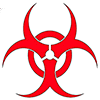BIOHAZARDS - Space Environment

Section revision March 2023
Near Earth Objects (NEOs), Potentially Hazardous Asteroids (PHAs) and More
inclusive of Meteors, Meteorites, Asteroids and Comets all have potential for great destruction.
The
Chelyabinsk meteor
was approximately 20 meters in size exploding in the air with a blast yield of 400-500 kilotons of TNT .
Meteor Crater
in Arizona shows the power of a nickel-iron meteorite 50 meters in size impacting with the force of 20 megatons of TNT. The majority of these objects have their origin within our Asteroid Belt but some can come from the Kuiper Belt and Oort Cloud. The Earth's distance from our Sun is one Astronomical Unit (au). One AU is equal to 150 million km or 93 million miles.
The Asteroid Belt exists between the orbits of Mars (1.66 AU) and Jupiter (52AU).
The Kuiper Belt exists from the vicinity of Neptune (30 AU) out to 55 AU.
The Oort Cloud (responsible for Comets) encompasses the edge of the Kuiper Belt out to
approximately one light year (63, 239 AU).
Currently the Jet Propulsion Laboratory (JPL) in Pasadena CA operates the Center for Near Earth Object Studies. The Chelyabinsk meteor was missed by JPL
and our
collective observation programs showing a need of increased surveillence of space objects.
NEOSHIELD NEOSHIELD-2
The chart below is a list of the currently known Near Earth Objects / Potentially Hazardous Asteroids as of
March 11, 2023 to the end of year 2030. These objects will come around or within 1/2 Lunar Distance (LD). 1 LD being the distance from Earth to the moon. Highlight yellow is close. Red are hugh objects that could bring planet-wide disaster upon impact. All these objects have damaging potential if their current paths bring them closer to the Earth.
.
